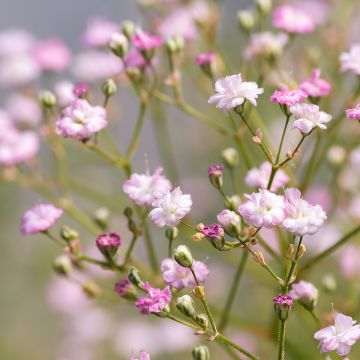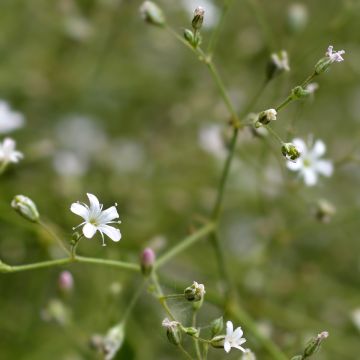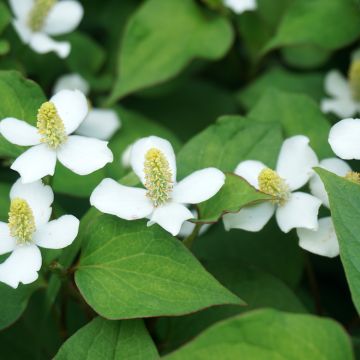

Gypsophila Rosenschleier


Gypsophila Rosenschleier
Gypsophila Rosenschleier
Gypsophila x paniculata Rosenschleier
Baby's Breath
This item cannot be shipped to the selected country
Delivery charge from €5.90
Delivery charge from €5.90
More information
Schedule delivery date,
and select date in basket
This plant carries a 12 months recovery warranty
More information
We guarantee the quality of our plants for a full growing cycle, and will replace at our expense any plant that fails to recover under normal climatic and planting conditions.
From €5.90 for pickup delivery and €6.90 for home delivery
Express home delivery from €8.90.
From €5.90 for pickup delivery and €6.90 for home delivery
Express home delivery from €8.90.
Does this plant fit my garden?
Set up your Plantfit profile →
Description
Gypsophila 'Rosenschleier', also known as Gypsophila 'Rosy Veil', is a spectacular plant, undoubtedly the best of the baby's breath plants. It is a vigorous perennial, forming a dense and compact cushion. Its dome disappears beneath an abundance of double flowers, which are initially white before turning candy pink. The numerous inflorescences form airy clouds. This variety tolerates winter humidity better than others. It is perfect in light soils, in the sun, and is ideal for rockeries or borders.
'Rosenschleier' baby's breath belongs to the Caryophyllaceae family. It is a hybrid resulting from the cross-breeding of G. paniculata and G. repens. The plant has a creeping and dense habit, spreading out in a flat dome. It will reach 50cm (20in) in height, gradually spreading to 40cm (16in) in width or more. Flowering takes place from June to July, until August if the soil remains slightly moist, in the form of numerous double pompom flowers, which are initially white before turning pink with age. The flowers are arranged in large panicles measuring 25 to 45cm (10 to 18in) wide. The plant disappears under a mist of pink and white, both very bright and extremely light. The blue-green evergreen to semi-evergreen foliage is composed of small linear, fleshy leaves, 1 to 3cm (1in) long, carried by first prostrate, then ascending stems.
'Rosenschleier' baby's breath has its place in scree gardens, and in beds with light and well-exposed soil, among salvias, old roses, and perennials like oriental poppies or gaura. This plant particularly enhances large-flowered perennials such as Iris germanica. Around shrubby peonies, it will form a misty carpet from which the shrub laden with flowers and insects will emerge, like a vision of paradise. This plant is ideal in dry gardens, in rockeries, as a wall covering, or on sunny embankments where it will play its role as a ground cover perfectly. This baby's breath also adapts very well to containers. Finally, it is a beautiful flower for dried or fresh bouquets.
Report an error about the product description
Gypsophila Rosenschleier in pictures




Flowering
Foliage
Plant habit
Botanical data
Gypsophila
x paniculata
Rosenschleier
Caryophyllaceae
Baby's Breath
Cultivar or hybrid
Other Gypsophila
Planting and care
'Rosenschleier' will particularly suit a rockery, but it will also thrive on a wall, in paving, in any stony and poor soil. Plant Gypsophila 'Rosenschleier' in deep, porous, dry to moist, well-drained soil. Limestone or neutral soil will be suitable. Excessive moisture in winter can greatly harm it by causing root rot. A gravel-rich soil yields good results. This plant requires a sunny but not scorching exposure. Choose its planting location carefully as its fragile, fleshy pivot root means the plant does not like to be moved. Prune the plant after flowering.
Planting period
Intended location
Care
-
, onOrder confirmed
Reply from on Promesse de fleurs
Summer flowering perennials
Haven't found what you were looking for?
Hardiness is the lowest winter temperature a plant can endure without suffering serious damage or even dying. However, hardiness is affected by location (a sheltered area, such as a patio), protection (winter cover) and soil type (hardiness is improved by well-drained soil).

Photo Sharing Terms & Conditions
In order to encourage gardeners to interact and share their experiences, Promesse de fleurs offers various media enabling content to be uploaded onto its Site - in particular via the ‘Photo sharing’ module.
The User agrees to refrain from:
- Posting any content that is illegal, prejudicial, insulting, racist, inciteful to hatred, revisionist, contrary to public decency, that infringes on privacy or on the privacy rights of third parties, in particular the publicity rights of persons and goods, intellectual property rights, or the right to privacy.
- Submitting content on behalf of a third party;
- Impersonate the identity of a third party and/or publish any personal information about a third party;
In general, the User undertakes to refrain from any unethical behaviour.
All Content (in particular text, comments, files, images, photos, videos, creative works, etc.), which may be subject to property or intellectual property rights, image or other private rights, shall remain the property of the User, subject to the limited rights granted by the terms of the licence granted by Promesse de fleurs as stated below. Users are at liberty to publish or not to publish such Content on the Site, notably via the ‘Photo Sharing’ facility, and accept that this Content shall be made public and freely accessible, notably on the Internet.
Users further acknowledge, undertake to have ,and guarantee that they hold all necessary rights and permissions to publish such material on the Site, in particular with regard to the legislation in force pertaining to any privacy, property, intellectual property, image, or contractual rights, or rights of any other nature. By publishing such Content on the Site, Users acknowledge accepting full liability as publishers of the Content within the meaning of the law, and grant Promesse de fleurs, free of charge, an inclusive, worldwide licence for the said Content for the entire duration of its publication, including all reproduction, representation, up/downloading, displaying, performing, transmission, and storage rights.
Users also grant permission for their name to be linked to the Content and accept that this link may not always be made available.
By engaging in posting material, Users consent to their Content becoming automatically accessible on the Internet, in particular on other sites and/or blogs and/or web pages of the Promesse de fleurs site, including in particular social pages and the Promesse de fleurs catalogue.
Users may secure the removal of entrusted content free of charge by issuing a simple request via our contact form.
The flowering period indicated on our website applies to countries and regions located in USDA zone 8 (France, the United Kingdom, Ireland, the Netherlands, etc.)
It will vary according to where you live:
- In zones 9 to 10 (Italy, Spain, Greece, etc.), flowering will occur about 2 to 4 weeks earlier.
- In zones 6 to 7 (Germany, Poland, Slovenia, and lower mountainous regions), flowering will be delayed by 2 to 3 weeks.
- In zone 5 (Central Europe, Scandinavia), blooming will be delayed by 3 to 5 weeks.
In temperate climates, pruning of spring-flowering shrubs (forsythia, spireas, etc.) should be done just after flowering.
Pruning of summer-flowering shrubs (Indian Lilac, Perovskia, etc.) can be done in winter or spring.
In cold regions as well as with frost-sensitive plants, avoid pruning too early when severe frosts may still occur.
The planting period indicated on our website applies to countries and regions located in USDA zone 8 (France, United Kingdom, Ireland, Netherlands).
It will vary according to where you live:
- In Mediterranean zones (Marseille, Madrid, Milan, etc.), autumn and winter are the best planting periods.
- In continental zones (Strasbourg, Munich, Vienna, etc.), delay planting by 2 to 3 weeks in spring and bring it forward by 2 to 4 weeks in autumn.
- In mountainous regions (the Alps, Pyrenees, Carpathians, etc.), it is best to plant in late spring (May-June) or late summer (August-September).
The harvesting period indicated on our website applies to countries and regions in USDA zone 8 (France, England, Ireland, the Netherlands).
In colder areas (Scandinavia, Poland, Austria...) fruit and vegetable harvests are likely to be delayed by 3-4 weeks.
In warmer areas (Italy, Spain, Greece, etc.), harvesting will probably take place earlier, depending on weather conditions.
The sowing periods indicated on our website apply to countries and regions within USDA Zone 8 (France, UK, Ireland, Netherlands).
In colder areas (Scandinavia, Poland, Austria...), delay any outdoor sowing by 3-4 weeks, or sow under glass.
In warmer climes (Italy, Spain, Greece, etc.), bring outdoor sowing forward by a few weeks.






















































